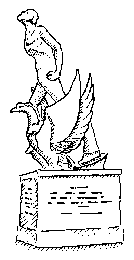
'Memorials to the Casualties of Conflict: Northern Ireland 1969 to 1997' by Jane Leonard (1997)[Key_Events] [KEY_ISSUES] [Conflict_Background] COMMEMORATION: [Menu] [Reading] [Summary] [Background] [Chronology] [Main_Pages] [Sources] The following report has been contributed by the author Jane Leonard, with the permission of the publisher the Community Relations Council. The views expressed in this report do not necessarily reflect the views of the members of the CAIN Project. The CAIN Project would welcome other material which meets our guidelines for contributions. 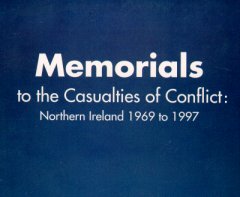 Memorials
Memorialsto the Casualties of Conflict: Northern Ireland 1969 to 1997 by Jane Leonard (1997) ISBN 1-898276-16-1 Paperback 38pp
Free copies are available from:
Community Relations Council Resource Centre
This report is copyright Jane Leonard (1997) and is included
on the CAIN site by permission of the author and the publishers. You may not edit, adapt,
or redistribute changed versions of this for other than your personal use
without the express written permission of the author and the publisher, Northern Ireland Community Relations Council . Redistribution for commercial purposes is not permitted.
Memorials Jane Leonard A report commissioned by the November 1997 ISBN 1-898276-16-1 Published under the Tel: 028 9022 7500 Illustrations by Tony ONeill
Contents
Acknowledgements An Crann/The Tree, the Arts Council of Northern Ireland, the British Army, the Deramore Group, the Grand Orange Lodge of Ireland, the National Graves Association, the Northern Ireland Office, the Northern Ireland Prison Service and the Royal Ulster Constabulary either provided information or access to archives. Catherine Moriarty and Nick Hewitt let me consult the Imperial War Museums National Inventory of War Memorials and generously shared their extensive knowledge of twentieth century war memorials. Angela Gaffney of the National Museum of Wales, Cardiff, sent details on memorials to Welsh servicemen killed in Northern Ireland. Robert Stradling of the University of Wales, Cardiff, briefed me on how Spaniards remember their Civil War. Rogelio Alonso and Justyna Kolackowska translated articles on recent commemorations in Spain and Eastern Europe. Maurna Crozier and Noirin McKinney provided sources and contacts. From 1995 to 1997 Jane Leonard was a Research Fellow at the Institute of Irish Studies, the Queens University of Belfast. She is currently the Community History Outreach Officer at the Ulster Museum.
Introduction In November 1994, the Irish Times columnist, Fintan OToole, suggested that the task of imagining memorials that do justice to the memory of all the victims of violence from all sides might help to unlock the imaginative sympathy that will be so necessary in the coming months. The early months of the cease-fires stimulated a widespread debate on forms of remembrance in Northern Ireland. Peace also facilitated previously taboo commemorations. These included a monument unveiled to civilians killed in Birmingham in 1974 and a Mass held in Belfast in memory of individuals killed in the conflict whose bodies have never been found. As with the Anglo-Irish Truce of 1921, different communities and organisations in Northern Ireland, Great Britain and the Republic of Ireland continued to erect (and to destroy) partisan monuments throughout the cease-fires of the 1990s. Recent attacks on new memorials in Counties Down and Fermanagh strengthen the argument that future commemorative projects should respect local sensitivities regarding design, inscription and the historic associations or contemporary demographic composition of the site chosen.
Case-studies from other conflicts i. The American Civil War, 1861-65 Memorial Day, the American equivalent to Remembrance Sunday, is observed on the last Monday in May in every state except Mississippi and South Carolina. On this public holiday, flowers are placed on war graves. Memorial Day, first observed in 1866, is usually cited as proof that the post-bellum United States healed its wounds by jointly commemorating its dead. In fact, the anniversary attracted controversy in its early decades. Some Union veterans viewed the decorating of Confederate graves as an insult to their dead comrades and there were regular clashes between floral parties in cemeteries. The American government did not take over the maintenance of Confederate graves until the external threat of the Spanish-American War of 1898 prompted a more inclusive approach to commemorating internal strife. ii. The Irish Civil War, 1922-23 The Fianna Fail party was in government from 1932 until the 1970s, apart from two brief periods in opposition. IRA memorials erected during these decades were often unveiled by cabinet ministers who had served on the anti-Treaty side in the Civil War. These memorials listed republican casualties from 1916 to 1923. This legitimised anti-Treaty fatalities of the Civil War by recording them alongside those killed in the earlier campaign against Britain. On some memorials, the names of later IRA casualties have been appended. In Nenagh, County Tipperary, the 1916-23 monument additionally records the names of the 1981 IRA hunger-strikers. Until recently, Irish casualties of different twentieth century conflicts were commemorated separately. In the early 1980s, the Glencree Centre for Reconciliation organised Walks of Remembrance around Dublin to jointly honour those killed in Irish, British and UN uniforms. During these walks, wreaths were placed on the main Irish World War I memorial by relatives of the leaders of the 1916 Rising. At the Four Courts, where the first Civil War fatalities occurred, similar tributes were jointly placed by descendants of pro and anti-Treaty commanders in that conflict. Such gestures facilitated the Irish governments establishment in 1986 of a National Day of Commemoration. This honours all Irish war casualties, including those killed on United Nations peacekeeping duties. It is held on the Sunday closest to the 11th July, the anniversary of the Anglo-Irish Truce of 1921. Wreaths are laid at a simple granite stone of remembrance, initially placed in the 1916-21 Garden of Remembrance in Dublin. The early years of this ceremony were controversial. In 1987, the government tried to cancel it following republican protests at the British Legions involvement. The opposition parties objected and the ceremony was held. When veterans of the 1916-21 IRA objected to the siting inside their memorial park of a monument implicitly commemorating Irish casualties from the two world wars, it was moved to the Royal Hospital, Kilmainham. Now an arts centre, this was formerly a home for Irish pensioners of the British Army and was also the residence of the British Commander in Chief in Ireland. Since 1987, this anniversary has not attracted controversy. It is usually attended by the President, the Taoiseach, senior army officers, diplomats and representatives of all churches and ex-service organisations. The inclusive character of the National Day of Commemoration is manifested in the invitations sent to all political parties north and south. The 1995 ceremony stressed the commitment to democracy of southern Irishmen and Irishwomen who ignored national neutrality to fight on the allied side in World War II. During the cease-fires, the National Graves Association erected new memorials to anti-Treaty casualties of 1922-23 and sought the restoration of state-owned republican monuments. Although the cease-fires facilitated a more pluralist approach to commemorating Irish participation in both world wars (including the attendance of the Chairman of Sinn Fein at the Dublin ceremony to mark the fiftieth anniversary of VE Day in 1995), they did not temper the character of Civil War commemoration. The feature film Michael Collins was released several months after the first IRA cease-fire ended. A popularly endorsed commemoration that jointly honours those who died under Collins command or fighting against him in the Civil War has yet to be found. iii. The Spanish Civil War, 1936-39 During the war, both sides erected temporary battlefield memorials such as placards hung on trees or wooden grave-markers. The post-war Franco government erected elaborate monuments to nationalist troops and dismantled the republican ones. Hundreds of streets were named after individual nationalist soldiers. Many Catholic churches erected plaques recording civilians and priests killed by republican Red forces. Following the restoration of democracy in Spain in 1975, the inscriptions on some nationalist memorials were erased and replaced by dedications to the republican forces. The construction and reception of the national memorial to the conflict, the Vallé de los Caidos (the Valley of the Fallen) was particularly divisive. Built outside Madrid between 1940 and 1959, the Vallé supposedly commemorated the dead of both sides. However, the only inscription on the monument, Fallen for God and Spain, 1936-39 RIP, expressly excludes the atheists and Marxists who died on the republican side. Thousands of republican prisoners of war are said to have died in the construction of the monument which consists of a basilica and crypt. Although envisaged as a common burial place, very few casualties from the republican side were transferred there. Families divided by the civil war were not permitted to use the Vallé as a unifying grieving point. One prominent case concerned the Escobar family. When they sought to move their brother, Lt. Escobar Valtierra, a young officer killed serving in the nationalist army, and their father, General Antonio Escobar, executed by the nationalist forces in 1940, to a joint grave, only the brothers body was transferred. The Vallé came to symbolise triumphalism and alienation rather than a healing shrine. Franco is himself buried there. The most evocative memorial to the republic was Pablo Picassos 1937 painting, Guernica, which showed the Basque town being obliterated by German planes aiding Franco. For over forty years it remained in French and American galleries. Its return to Madrid in 1981 was seen as a symbolic christening of the newly democratic Spain. The rehabilitation of the republican dead has included the restoration of plots in cemeteries and erection of monuments. Those to the International Brigades include the David and Goliath sculpture in Barcelona (unveiled in 1988) and a monument in San Martin de la Vega (unveiled in 1994). This belated recognition of the defeated has not usually been accompanied by attempts at inclusive commemoration. A memorial erected in Santander in 1995 is unusual in being dedicated to the dead of both sides. iv. Commemorations In Post-Communist Eastern Europe Until these recent upheavals, the civil wars in Russia and Poland in the early 1920s were never formally remembered. The Red Armys defeat of the White forces was merged into a commemoration of the revolution. Outside the Soviet Union, émigré Russians maintained a pride in the White armies and mourned its casualties. The fall of communism has elevated remembrance of White commanders. In the Cossack town of Krasnodar, a statue of General Lavr Kornilov was erected in 1994. In 1995, Warsaw marked Marshal Jozef Pilsudskis successful defence of the city against the Red Army in 1920 by unveiling a statue of him. Underneath is inscribed his declaration: "to be conquered and not to submit - that is the victory" which was adopted by the Solidarity movement of the 1980s. v. Recent Urban Peace Sculptures In 1991, the Quebec artist, Alex Magrini, devised a Guns-For-Art programme in which weapons would be converted to sculptures. His project was inspired by the Colonne de la Grande Armee in Paris, a column fashioned from 1,200 captured cannon to commemorate Napoleons victory at Austerlitz in 1805. Magrinis sculptures employ fragments of destroyed firearms rather than melted down weapons so that reminders of their original function and new role remain visible. One work, Symphonie Pour La Non-Violence, contains a piano, the keys of which are partly fashioned from sections of rifle butts. Of other recent sculptures, three significant works were unveiled in Birmingham, Alabama, in 1993 to mark the thirtieth anniversary of the civil rights marches. They depict actual incidents from 1963 and are entitled Fire Hosing of the Marchers, Childrens March and Police Dog Attack. What makes this stark series interesting (the snarling leaping dogs commonly produce responses of frozen fear from visitors) is the commitment of the artist, James Drake, to aggressive sculpture as a means of promoting compassion in the viewer.
Existing partisan memorials to the Northern Ireland Conflict This section categorises the location and forms of existing partisan memorials to those killed since 1969. i. Outdoor Memorials Republican memorial, Crossmaglen, Armagh; Very few memorials dedicated to casualties of the Troubles are figurative sculptures. Exceptions include a Cuchulainn statue in the Derry City Cemetery Republican Plot, a figure of a bomb disposal operator in an Army School of Ammunition barracks in Warwickshire and a statue of Lord Mountbatten erected on Horse Guards Parade in London. Until the cease-fires, the most common urban republican memorial was the street mural. Since then, more permanent monuments including elaborate marble plaques and gardens of remembrance have been dedicated. Examples include those in Andersonstown, the Short Strand and Ligoniel. Earlier murals, such as the one to the hunger-striker, Bobby Sands, in Twinbrook have been renovated and have had permanent plaques appended. IRA memorials are often erected at the site of death. Decades may elapse before they are commissioned, as with the monument unveiled in January 1997 near Brookeborough in County Fermanagh, which commemorates two IRA members killed following a raid on the local RUC station in 1957. Loyalist fatalities are rarely commemorated in this way. Some recent exceptions include UVF wall plaques on the Shankill and Woodstock Roads in Belfast. 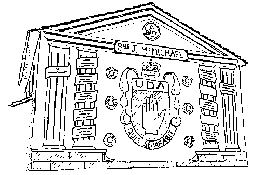 UDA commemorative mural, Sandy Row, Belfast, painted in 1994. Like republican memorials, loyalist murals borrow heavily from earlier commemorations. Many link paramilitary casualties with the 36th Ulster Divisions losses in World War I and use injunctions and emblems associated with that conflict such as lest we forget and poppy motifs. A 1996 mural painted in East Belfast shows two portraits, the 1916 Somme VC hero Billy McFadzean, and William Miller, a UVF member shot by the RUC in 1983. Monuments to soldiers are usually placed inside barracks and garrison churches. Outdoor exceptions include the plaques at Ballygawley in County Tyrone where eight soldiers were killed in a coach explosion in 1988. A granite boulder unveiled outside Castlewellan in County Down in November 1996 marked where three members of the UDR were killed in 1980. It was destroyed two weeks later. 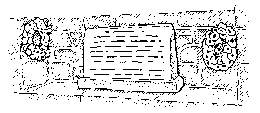 Caledon, County Tyrone - roadside plaque to three members of the RUC. The wreaths also remember a nun killed in the same IRA bomb, who is not recorded on the plaque. Outdoor police memorials are also rare. In October 1995, a plaque was unveiled in Caledon, Country Tyrone marking where three policeman and a nun were killed by an IRA bomb in 1990. Its unveiling ceremony, which included a presentation by local police to the convent orphanage where Sr. Catherine Dunne had worked, attracted an unusually wide cross-community attendance. Obelisks, boulders, cenotaphs and plaques mark the sites of several large-scale killings of civilians. The memorial to nine civilians killed in the Shankill Road fish shop bombing of October 1993 consists of a refurbished old Belfast street lamp placed in a new peace garden. The lamps inscription has a secondary dedication to all innocent victims of terrorism. Similarly, the plaque at Greysteel, where seven pub customers were killed one week after the Shankill bomb, remembers all those who have died as a result of the troubles. The most common war memorials in Northern Ireland are those erected in the inter-war years to the dead and the survivors of World War I. Many additionally bear plaques recording World War II casualties and survivors. Remembrance Sunday ceremonies each year include prayers and wreaths laid in memory of local casualties of the Troubles. Few World War I memorials also record subsequent deaths in the conflict in Northern Ireland. Over the last decade, new memorials to both world wars have been erected in towns such as Fintona, Millisle and Newtownabbey. Their inscriptions obliquely include police and service casualties of the Troubles: in memory of members of the forces who gave their lives in both world wars and in subsequent conflicts. The war dead on the new memorial at Broughshane in County Antrim include a prison officer and a soldier killed in 1982 and 1992. 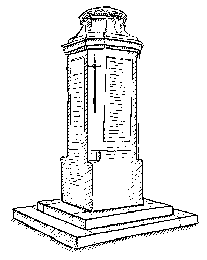 St. Brelade, Jersey - This First World War memorial is dedicated a ses enfants morts pour la patrie. The final inscription switches language and tone: Other conflicts, Northern Ireland, Harris, I.M., 1972. Public memorials erected in Ireland after World War I recorded the deaths and service of volunteers (conscription was not applied to Ireland) from many different religious and political traditions. Whether war memorials in Northern Ireland should acquire an additional or altered symbolism by recording casualties among the security forces during the 1969-94 conflict has been a controversial issue. A Catholic family in County Down spent sixteen years campaigning for the name of their son, a UDR private killed by the IRA in 1980, to be added to the war memorial in Downpatrick. In November 1996, the local council sanctioned the unveiling of a plaque recording his name and regiment on the wall beside the monument. This compromise is to be copied by other councils. Similar dilemmas have occurred in England, Wales and further afield. As with the commemoration of British servicemen killed in Malaya and Kenya, there has been uncertainty over the status of the conflict in Northern Ireland. Following a ruling by a district council in Cheshire in 1993, the recording of casualties from Northern Ireland on local cenotaphs is now permitted. One of the most striking photographic images of the Troubles was the bronze bowed soldier on the Enniskillen war memorial surrounded by the debris of the 1987 Remembrance Sunday bombing. In 1991 under the supervision of a local architect, Richard Pierce, the memorial was restored. Eleven bronze doves dedicated to the memory of our neighbours who died near this spot were set into the restored memorial. This design and wording aimed to promote reconciliation in the local community. 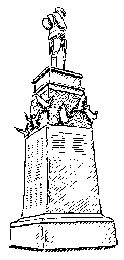 Enniskillen, County Fermanagh - the restored war memorial with doves added to represent those killed in the 1987 IRA bomb. Other proposed memorials have been rejected or postponed on account of the angry sentiments they express. In 1993, councillors in Antrim town postponed the unveiling of an outdoor memorial dedicated to policemen murdered by the enemies of Ulster. They feared that the wording put council members and officials at risk of being attacked by paramilitaries. The memorial was not unveiled until October 1995. The alterations to the Enniskillen memorial attracted some criticism from bereaved relatives and friends of those killed in 1987 precisely because the doves were deemed too placatory. The inscriptions terming of the victims as neighbours concealed the sectarian nature of the bombing. On two occasions, doves have been stolen from the memorial, possibly as an expression of non-endorsement of its new sentiments. Similar bitterness has been expressed by the relatives of those killed in the 1974 Dublin and Monaghan bombings at the inappropriate scale and location of the first memorial erected by Dublin Corporation. A more elaborate memorial bearing the names of those killed in 1974 was unveiled in September 1997 at the site of the Talbot Street bombings. Since the eighteenth century, outdoor military and political monuments in Ireland have repeatedly been attacked. The obelisk commemorating William of Oranges victory at the Battle of the Boyne was blown up during the Irish civil war in 1923. In 1969, loyalists bombed the grave of the 1798 leader, Theobold Wolfe Tone, at Bodenstown in County Kildare. In 1973, the IRA bombed the statue of Governor Walker, prominent in the 1688 siege of Derry. Public memorials to the Troubles are regularly desecrated. The first plaque commemorating civilians killed in an Ormeau Road bookmakers shop in 1992 was destroyed and had to be replaced. The memorial to eight workmen killed at Teebane, County Tyrone, also in 1992, has frequently been attacked. In the summer violence of 1996, it was completely obliterated. A replacement stone was unveiled in January 1997. ii. Memorials inside army barracks and police stations The three principal UDR memorials are a stained glass window erected in 1992 in Belfast City Hall, the chapel of the Royal Irish Regiment in St. Annes Cathedral, Belfast (which incorporates memorials to the earlier UDR and Royal Irish Rangers), and an obelisk unveiled in St. Patricks Barracks, Ballymena, in 1995. Additionally, there are local UDR battalion memorials, usually sited inside barracks and garrison churches. Some memorials inside army bases were provided by civilians. A rose-garden in Thiepval Barracks, Lisburn, was provided by anonymous residents of Andersonstown in memory of four soldiers killed in West Belfast in 1973. The garrison chapel in Thiepval Barracks includes memorials erected by the people of Lisburn to six soldiers killed after participating in a charity fun run in Lisburn in 1988. The principal RUC memorial consists of two illuminated books of remembrance, recording casualties incurred since 1922 by the RUC, the RUC Reserve and the Ulster Special Constabulary. These volumes are kept at RUC Headquarters, Knock, Belfast. A stained glass window commemorating police casualties in the same period was unveiled in the Police Federations headquarters at Garnerville in Belfast in 1988. Another stained glass window, commemorating RUC and civilian deaths in Northern Ireland since 1969, was commissioned by Belfast City Council in 1993, and was unveiled in the City Hall in 1999. In the entrance halls of most RUC sub-division headquarters, such as Ardmore Station in Newry, there are wall plaques recording local police casualties. These were generally erected during the recent conflict but several retrospectively list police killed in the 1920s and 1950s. At Crumlin Road Prison in Belfast and at the Prison Service Training College in Millisle, County Down, there are a number of memorials to prison officers. 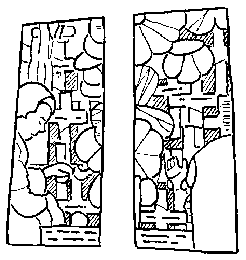 The Guildhall, Derry. Detail of a stained glass window designed by Peter Rooney, 1988. The names on the crosses are of those killed on Bloody Sunday. iii. Government buildings and the offices of political organisations The most striking memorial inside a local government building is a stained glass window inside the Guildhall in Derry. Dedicated to the innocent people killed during the Troubles in the Derry area, it features crosses bearing the names of those killed on Bloody Sunday. The contrast with the Guildhalls other commemorative windows, principally honouring Derrys participation in both world wars, is dramatic. iv. Churches There do not appear to be any plaques inside Catholic churches to police, army or paramilitary casualties. Only one example has been found of a civilian memorial located inside a Catholic church. This is a stained glass window inside the new church at Forkhill in South Armagh. Dedicated in April 1997, it remembers Patrick Toner, a child killed when an IRA booby trap bomb exploded in a nearby field in 1975. Occasionally, monuments are erected in the precincts of Catholic churches. A small cross outside St. Matthews Church in the Short Strand, Belfast, commemorates Henry McIlhone, killed by loyalists during the Short Strand clashes of June 1970. Although McIlhone was not a member of the IRA, he is listed in its roll of honour because of his role in defending the local Catholic population. Outside St. Macartans Church in Loughinisland, County Down, a boulder lists six Catholics killed by the UVF as they watched a Republic of Ireland World Cup football match on television in June 1994. St. Marys Church, Creggan, Derry, staged a striking commemoration in January 1997. A temporary display inside the church entitled The Way Of The Cross: The Road To Bloody Sunday profiled each victim of Bloody Sunday under a candle-lit station of the cross. The inscriptions on church plaques to police and UDR echo the injunctions on earlier world war memorials. The phrases lest we forget, greater love hath no man that this, than that he lay down his life for his friends and they shall not grow old as we that are left grow old are regularly used. The cause of death is usually given as murdered by terrorists. One plaque to two UDR members in a Free Presbyterian church in County Londonderry states that they were murdered by the enemies of Ulster. Whereas IRA memorials usually specify that death was for Ireland or in the cause of freedom, those to members of the security forces simply state that they were killed in the course of their duty or in the service of their country. A rare exception is the stained glass window in Lisanelly Barracks Chapel, Omagh, which honours soldiers of the Light Infantry killed in the struggle to secure a just and free society in Northern Ireland. v. Cemeteries vi. Fraternal, musical and sporting memorials 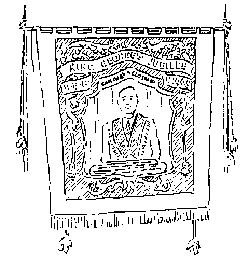 Closkelt, County Down - Royal Black Preceptory banner with a portrait of a draper killed with his wife and daughter in an IRA bombing of his shop and home in 1976. The banner states that he met his death at the hands of the enemies of Ulster. Loyalist and republican bands are frequently named after individual casualties. There is a long tradition of composing ballads and tunes in memory of republican fatalities. Several commemorate the ten hunger-strikers who died in 1981. A tune entitled Hugh McConnell of Bessbrook was composed by an Orange flute band in County Armagh to commemorate a policeman killed in 1978. Sport provides another arena of commemoration. Policemen and soldiers are perpetuated by various angling, soccer, rugby and golf trophies. Some of the Gaelic Athletic Associations grounds, competitions and trophies commemorate deceased IRA members. Each year, South Armagh teams compete for the Michael McVerry Cup, in memory of an IRA casualty of 1975. vii. Educational memorials
Existing and proposed general memorials to the Conflict The cease-fires inaugurated a vigorous public debate on suitable forms of commemorating the casualties, issues and lessons of conflict. A national memorial was proposed within a few days of the IRA cessation of violence in August 1994. Some journalists and politicians argued that the statue of Lord Carson on the driveway at Stormont should be replaced by a new peace sculpture, which politicians, civil servants and media working in post-war Northern Ireland would daily have to pass and heed. Early proposals included a wall recording the names of victims in date order similar to the Vietnam Veterans Memorial in Washington DC. The precedent of Berlin in 1990 produced suggestions that such a memorial could be constructed from one of the now redundant peaceline walls in Belfast, or by retaining some of the sentry towers overlooking border crossings and boulders which had closed minor roads. The post-communist approach to public sculpture in Eastern Europe was invoked in suggestions that the Carson statue and other unionist figures outside Belfast City Hall be removed to sculpture parks. In January 1995, the Forum for Peace and Reconciliation in Dublin asked organisations counselling victims of violence their views about commissioning a memorial. An important point was made by the late Senator Gordon Wilson, who noted that those bereaved by the Troubles did not require a monument to be reminded of their loss but that the outside world did need this reminder. Several of the witnesses at the Forum session argued for practical memorials rather than symbolic monuments. The following is a summary of existing peace memorials and of commemorative projects which were inaugurated between 1994 and 1997: i. Sculptures and installations Some sculptures inspired by the Troubles were spontaneously conceived rather than commissioned. These include F.E. McWilliams Women of Belfast, which depict shoppers mutilated and traumatised by the Abercorn bomb in central Belfast in 1972. Other artistic responses include installations by Bobby Ballagh (Bloody Sunday, 1972), photographic sequences by Paul Seawright (Sectarian Murders Series, 1987-88) and text walls by Shane Cullen (Fragmens Sur Les Institutions Republicaines, 1996). Among the many poems dedicated to victims of the conflict are Padraic Fiaccs The Ditch of Dawn and Michael Longleys Wreaths. In late August 1994, just before the IRA cease-fire began, the Down Arts Centre in Downpatrick announced a forthcoming installation, Pieces, by the sculptor, Eilis OBaoill. This was to feature a traditional dry stone wall of over three thousand numbered uneven stones, each representing a death in the Troubles. Logistical problems resulted in the cancellation of the exhibition which has not been staged elsewhere since. The anonymous and uneven quality of the stones promised a radically different remembrance from conventional memorials which usually list the dead alphabetically or in date order. In August 1995, Peter Rooney, a Belfast artist and sculptor, erected a plywood peace dove on an empty plinth at Carlisle Circus in North Belfast. Others were planned for various venues across Northern Ireland. Within days, loyalists had burnt and toppled the dove, regarding it as a squatter. A statue of Hugh Hanna, a prominent nineteenth century Presbyterian preacher and political orator, formerly occupied the Carlisle Circus plinth. It was damaged by an IRA bomb in 1970 and placed in storage by Belfast City Council. Following protests from unionist politicians at the usurping of Hannas statue, Belfast City Council agreed to its restoration and future re-erection. Some Presbyterian elders and nationalist councillors fear that the return of Reverend Hanna may worsen sectarian tension in the area. (Rooney has since installed his doves at other significant sites: on Cave Hill in May 1996; outside Milltown Cemetery on Easter Sunday 1997; and on the Lower Ormeau in July 1997. These installations were not damaged.) Over three days during Easter 1996, Hilary Gilligan, an art student at the University of Ulster chalked the names of 3,300 individuals killed in the Troubles on the pavement of Royal Avenue in Central Belfast. Unlike the peace dove at Carlisle Circus, whose phoenix-like appearance appeared threatening to loyalists, this temporary testament, with the human and weary presence of the kneeling artist, was positively received. Passing shoppers, church-goers and police patrols paused to offer help with the transcription and to share memories of particular casualties. The only opposition came from passing Apprentice Boys of Derry, returning from an Easter Monday parade, who regarded the gesture as pavement graffiti. Other recent installations include Alistair MacLennans 1997 exhibition in Dublin, Body of Earth 1969-96. This evokes burial chambers and hospital wards while an audio recording recites in alphabetical order the names of those killed in Northern Ireland. ii. Museums and meeting centres
In January 1997 An Crann/The Tree, a projected museum based on personal testimonies of the Troubles, opened a Belfast office. As with Holocaust museums in Europe and the United States, An Crann aims to counsel as well as educate. It will combine storytelling and workshops with traditional displays of artefacts, photographs and sound recordings. Two key elements are planned for this museum. A massive mural will depict the historical, cultural and religious experiences that engendered contemporary Northern Ireland. A central offertory room, like the function of a cairn in earlier societies, can be visited by those seeking a private place of contemplation. Here, tributes to the dead, in the form of letters, photographs and artefacts can be placed, as is done at the Vietnam Veterans Memorial in Washington. These remembrances will be preserved by the museum. Since its establishment in December 1994, An Crann has collected 4,500 testimonies. Existing museums have also expressed a commitment to chronicling recent decades. The Arts Council is seeking to establish a modern art gallery whose remit will include recording personal experiences of the Troubles. A competition for architecture students to design a building for the peace talks was organised in December 1994 by Queens University, Belfast. The brief stipulated a structure which would defuse confrontation between negotiators. The winning design placed the building on an artificial island which would precariously overhang the River Lagan to remind participants of the fragility of peace. The approach road itself constituted a dramatic peace memorial, requiring negotiators to walk around twenty five unevenly sized walls (similar to border check-points) in order to reach the river. Each wall was sized in proportion to the number of people killed in each year of the Troubles. The originality and flexibility of these entries and other relevant projects conducted by architecture students in 1995 and 1996 offer a good precedent should any exhibition of peace memorial designs be commissioned. Practical memorials, aimed at promoting communication in the playgrounds of Northern Ireland, have been erected by the cross-community organisation, Women Together. Two benches, in Belfasts Queen Mary Park and Victoria Park, were unveiled in October and December 1995. Each commemorates all the victims of the conflict. iii. Published Casualty Lists A more detailed biographical register of casualties is to be published by the Deramore Group. Provisionally entitled The People Who Died, it includes deaths occurring outside Northern Ireland and will be published in either book or database format. [Entitled Lost Lives, this massive volume was published in 1999.] Counting the Cost, an exhibition curated by Isobel Hylands, listed the casualties of the Troubles in date order. It toured Ireland during 1995. On the first anniversary of the IRA cease-fire, this list, re-named Taking Account, was displayed on an electronic screen in Belfasts Shaftesbury Square. Several bereaved families regarded an electronic bill-board an inappropriate medium for honouring the dead while others resented having their relatives listed alongside their perceived political and military opponents. As with the Enniskillen war memorial, the Shaftesbury Square screening highlighted how images of reconciliation sometimes produce contradictory responses of alienation. Separate casualty lists were maintained throughout the Troubles or compiled during the cease-fires. These include the RUC Books of Remembrance; publications such as The Last Post: The Details And Stories Of The Republican Dead (Dublin, 1976); lists of UVF and UDA casualties published in Combat and New Ulster Defender; and an Orange roll of honour, recording RUC, UDR and civilian casualties, published in the Orange Standard. iv. Educational, cultural and environmental memorials
Conclusion This report summarises the contemporary history and geography of commemorating the Northern Ireland conflict. It notes how commemoration in other societies has festered rather than cured civil war divisions. Despite their relative political stability, Spain and the Republic of Ireland are still seeking healing methods of commemorating civil wars of over sixty years ago. With the cease-fires so recently restored, it would be naive to suggest that the time is opportune for commissioning a peace memorial. The negative responses to some independent commemorations staged during the cease-fires reinforce the need for wide consultation. Within Northern Ireland, the opinions of the bereaved, the injured, the ex-prisoners, and those who lost their homes and livelihoods through violence ought to be sought. Elsewhere, the views of families of British and Irish servicemen and civilians killed outside Northern Ireland should also be determined. The public debate on commemoration, prompted by the cease-fires, should be encouraged to develop. This could be done by commissioning an exhibition of different options for a memorial to commemorate victims of the conflict. Instead of a monument naively proclaiming the arrival of peace, such a memorial could convey a societys aspiration to restore peace while also honouring the dead. The designs of Irish, British and international artists and sculptors, art and architectural students and community arts groups could form a touring exhibition throughout Northern Ireland, the Republic and Britain. Public responses to this exhibition would inform any resulting competition brief. The first casualty of peace is often the memory of war. Reporting the opening of An Crann in the Observer in January 1997, Mary Holland recalled the mood of 1994: There was public discussion of the need to remember and honour the dead by erecting a formal memorial, but this was eclipsed by the desire to transcend the past and to embrace the hopes embodied by President Clintons visit and Van Morrisons song Days Like This. The architect of the Vietnam Veterans Memorial, Maya Lin, hoped to bring out in people the realisation of loss and a cathartic healing process. While American public opinion was deeply divided over the ethics of participation in Vietnam, the memorial nonetheless had the straightforward task of commemorating one sides casualties - those who died in American uniform. If a peace sculpture is ever to be commissioned for Northern Ireland, its role, in expressing the grief and reconciling the post-war hopes of different bereaved communities within and beyond Northern Ireland, will be far more complex and challenging than the Vietnam project. To gauge this complexity, consider the expressions of loss, desire for revenge, national and religious identity, bewilderment and continuing vulnerability on some existing memorials: In memory of Robert James Harrison, a faithful and devoted member of this lodge for many years who was brutally murdered by the enemies of Ulster on 5th February 1971 whilst serving his Queen and country. Gone but not forgotten 1 To the memory of Private William Robert Davies, Royal Regiment of Wales. A son of this village. Killed at Lichfield, June 1st 1990. During his 18 years he contributed richly to the life of this community in sport and companionship 2 In proud and loving memory of one of Irelands noblest sons, Captain Michael McVerry, O/C 1st battalion, South Armagh Brigade, Óglaigh na hEireann, born at Cullyhanna 1 December 1949; killed in action by British forces of occupation at Keady RUC barracks, 15 November 1975 3 In remembrance of John McMichael. Quis Separabit. Died At The Hands Of The Infamous IRA, December 22nd, 1987. Lest We Forget. UDA, UFF, UVF, LPA 4 In memory of Paul William John Maxwell, who with the Earl Mountbatten of Burma and others was killed in an explosion at Mullaghmore on the 27th August 1979. Paul was a pupil of this school from 1975 until his death. They that go down to the sea in ships and occupy their business in great waters: these men see the works of the Lord: and His words in the deep 5 In memory of Jack Duffin aged 66 years, Willie McManus aged 54 years, Christy Doherty aged 52 years, Peter Magee aged 18 years, James Kennedy aged 15 years. Murdered for their faith on 5th February 1992. Also in memory of other local people who have been murdered for their faith. Go ndéanaí Dia trócaire ar a n-anamacha" 6 Restorick (Stephen) (Lance Bombardier 3RHA), killed at Bessbrook on February 12, his parents and brother wish to thank all who sent condolences. May his death be a catalyst for peace. 7
Notes 2 Plaque to army recruit killed by the IRA in England, erected beside the village war memorial in Pontarddulais, West Glamorgan, South Wales.3 Monument to IRA member, erected in Cullyhanna village square, County Armagh.4 Wall mural to UDA leader, Roden Street, Belfast.5 Plaque to teenager killed by the IRA in County Sligo, erected in Portora School chapel, Enniskillen, County Fermanagh.6 Plaque to six Catholic civilians killed by the UFF, erected on wall of bookies shop, Ormeau Road, Belfast.7 Acknowledgement placed by the family of a British soldier killed by the IRA after the first cease-fire ended, Irish Times, 8 March 1997.
Further reading The main sources for this report were archives, newspapers, journals and interviews. Details of recent sculptural commissions were taken from newspapers and from art journals including Circa, Sculpture, SSIN (Sculptors Society of Ireland Newsletter), Art Bulletin (Journal of the Representative Body for Professional Artists in Ireland), Circumspice (Newsletter of the Public Monuments and Sculpture Association, London) and Perspective (Journal of the Royal Society of Ulster Architects). Relevant secondary sources include:
|
CAIN
contains information and source material on the conflict
and politics in Northern Ireland. CAIN is based within Ulster University. |
|
|
|||
|
Last modified :
|
||
|
| ||
